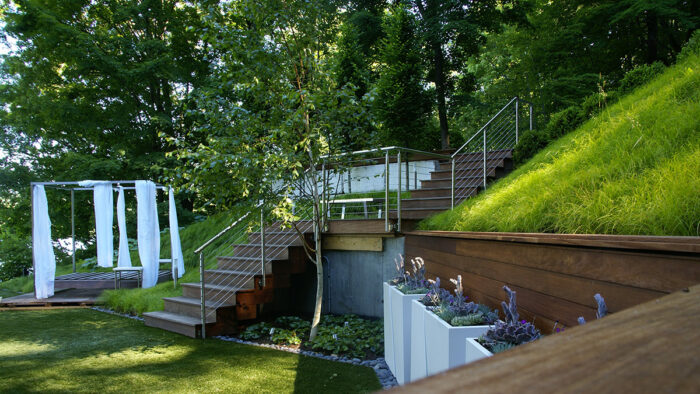
We design gardens in northwestern Connecticut’s Litchfield Hills, and many of our clients’ properties have sections that are rocky and steep. Embracing the unique contours of each site, we have built rock gardens, terraces, and plantings that flow downhill. We see each hillside as an opportunity to put together a satisfying plant palette that is easy to maintain and beautiful to behold. A bonus with slopes is that they provide good drainage by their very nature.
The first thing to consider when developing a planting plan is the direction the slope faces and the kind of sun exposure it has. Soil conditions and water availability will also help you decide what to plant. We are big proponents of working with what nature has provided. If there is ledge present, let it serve as your garden’s bones, and expose more ledge where you can instead of trying to cover it up. Starting from the ground up, we’ve assembled a list of some of our favorite tenacious stunners that will beautify almost any hillside.
Perennials Cover Steep Terrain with Tempting Textures
Pennsylvania sedge softens a shaded slope
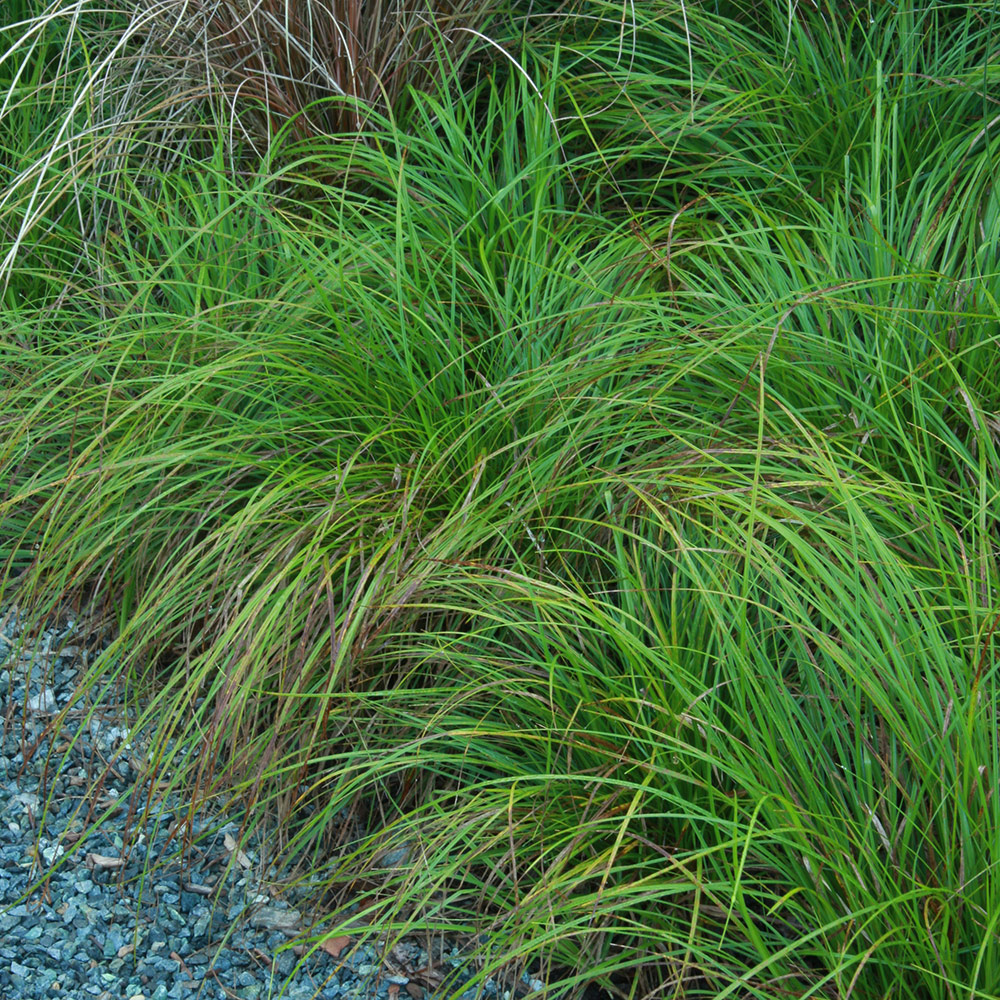
Name: Carex pensylvanica
Zones: 3–8
Size: 6 to 12 inches tall and wide
Conditions: Partial to full shade; average to dry, well-drained soil
Native range: Eastern North America
Shade-loving Pennsylvania sedge is excellent when planted en masse, especially in areas where erosion control is needed. It has fine, arching, semi-evergreen foliage that can serve as a cloudlike lawn alternative in spots that are too shady for turfgrass and too steep to mow. It loves arid, well-drained soil, which makes it an ideal ground cover for dry shade. On a slope, plugs of Pennsylvania sedge can be placed 12 inches apart on center; the plants will quickly fill in to form a lush, dense carpet. For a similar look, sowing a no-mow seed mix is a budget-friendly alternative worth considering.
‘Sulphureum’ epimedium is as charming as it is resilient

Name: Epimedium × versicolor ‘Sulphureum’
Zones: 5–9
Size: 9 to 12 inches tall and 9 to 18 inches wide
Conditions: Partial to full shade; average to dry, well-drained soil
Native range: Hybrid
‘Sulphureum’ epimedium is another tough, deciduous ground cover that handles dry shade without complaint. It blooms in early spring, so we like to cut back the old growth in late winter and carefully apply a layer of fine, dark-colored mulch to enhance the exuberant, sulphur-yellow floral display. The heart-shaped leaves emerge with red tints, maturing to form lovely green mounds that flush red again in autumn. It is a great companion plant for spring-blooming bulbs and other ephemerals that die back in summer. By then, ‘Sulphureum’ will step in to fill the space with neat masses of foliage.
‘Bevan’s Variety’ bigroot geranium is easy to propagate
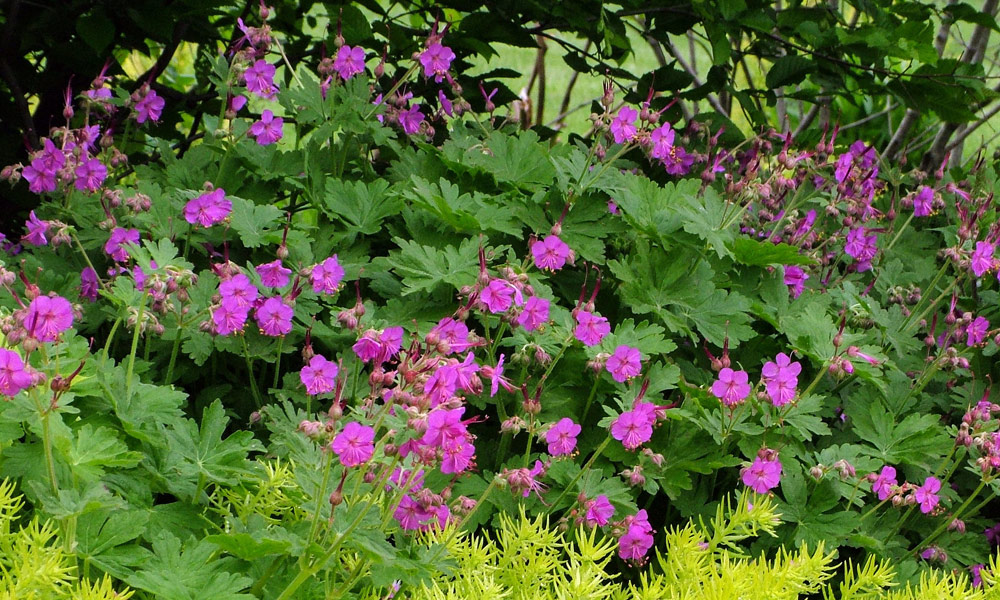
Name: Geranium macrorrhizum ‘Bevan’s Variety’
Zones: 4–8
Size: 9 to 12 inches tall and 18 to 24 inches wide
Conditions: Full sun to partial shade; average to dry, well-drained soil
Native range: Southern Europe
If you are looking for a fast-growing ground cover for a dry, sunny spot, ‘Bevan’s Variety’ bigroot geranium could be just the plant you need. Its thick rhizomes make it quite drought tolerant and helpful for stabilizing steep grades. The roots and stems spread gradually outward to form a 2-foot-wide mat. To help the plants spread even more quickly, we break off stems in spring and scratch them right into the soil in a new location. These cuttings will need to be kept moist until they root, but once they are established they will take care of themselves. ‘Bevan’s Variety’ has deep magenta flowers and nicely scented foliage that can be semi-evergreen in milder winter climates.
‘Immortality’ bearded iris looks lovely alone or in groups
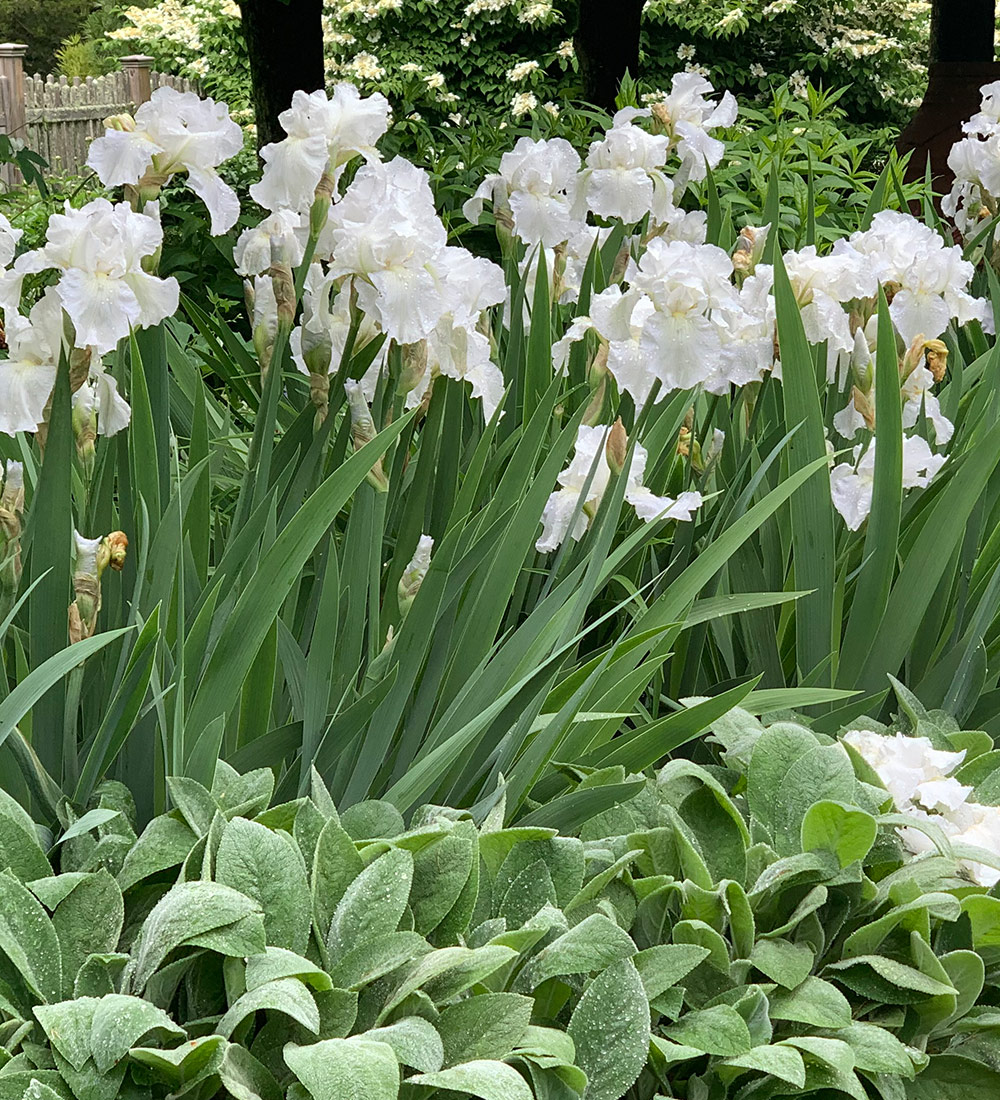
Name: Iris germanica ‘Immortality’
Zones: 3–9
Size: 24 to 30 inches tall and 12 to 24 inches wide
Conditions: Full sun; well-drained soil
Native range: Southern Europe
‘Immortality’ bearded iris is a reliable rebloomer that delivers bountiful clear white flowers with pale yellow throats in both spring and fall. Masses of the crisp, fresh blooms look stunning standing tall on a hillside, and a single plant exudes regal elegance when set against a rock or surrounded by a clean green carpet of ground cover. Pair it with a silver-leaved companion for a frosty color effect.
‘Little Spire’ Russian sage does not flop
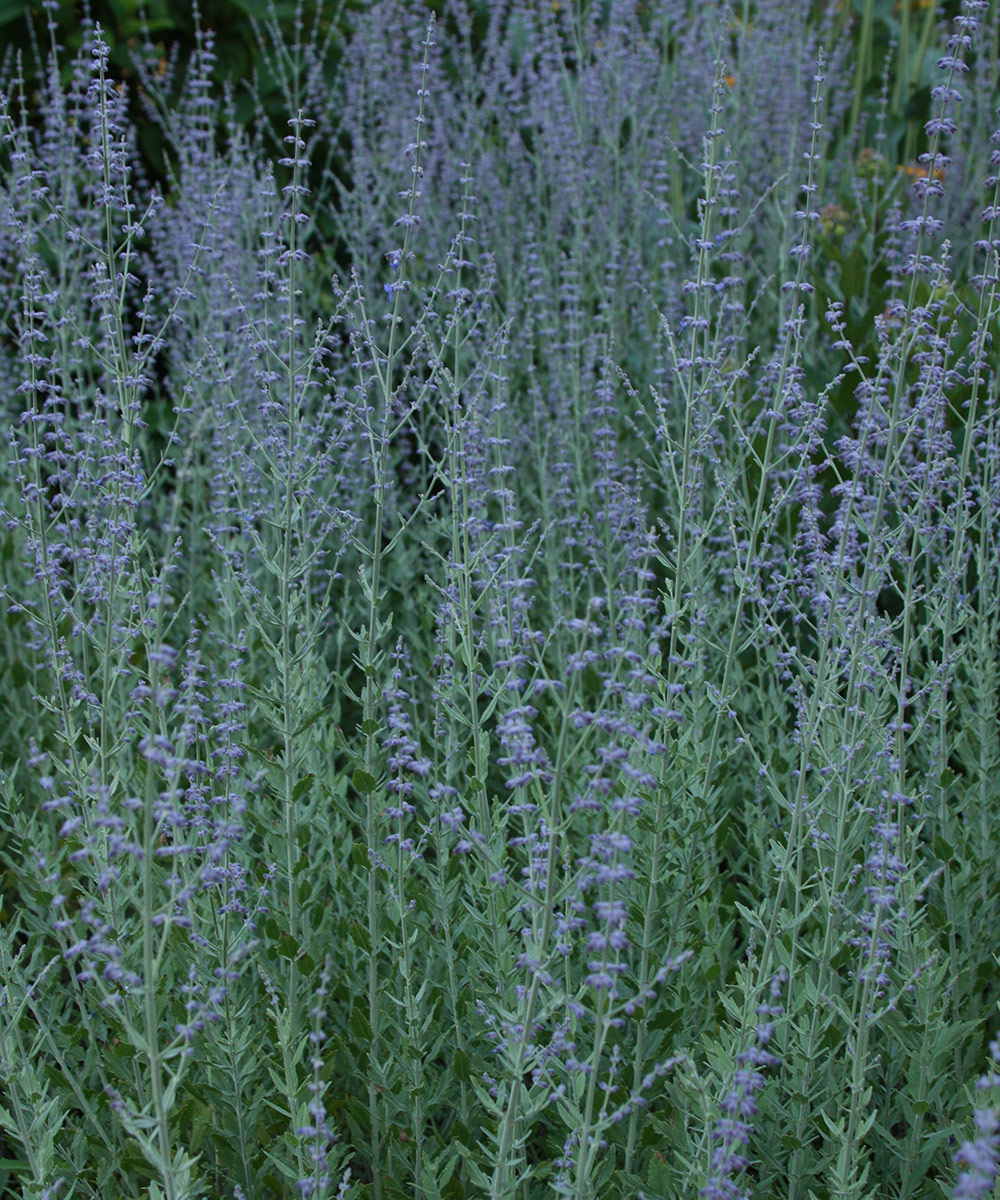
Name: Salvia yangii ‘Little Spire’
Zones: 5–9
Size: 24 to 30 inches tall and 18 to 24 inches wide
Conditions: Full sun; dry to average, well-drained soil
Native range: Southwestern and central Asia
‘Little Spire’ Russian sage offers a welcome dose of late summer blue for any well-drained spot with full sun. This cultivar has the same silvery foliage and airy texture as the straight species, just delivered in a smaller, tidier package. While masses of Russian sage do look quite charming sprawling over each other on an embankment, if you are looking for a more managed, vertical rock garden element, ‘Little Spire’ is your best bet.
Low, Spreading Shrubs Are Excellent for Erosion Control
‘Streibs Findling’ bearberry cotoneaster stays very low to the ground
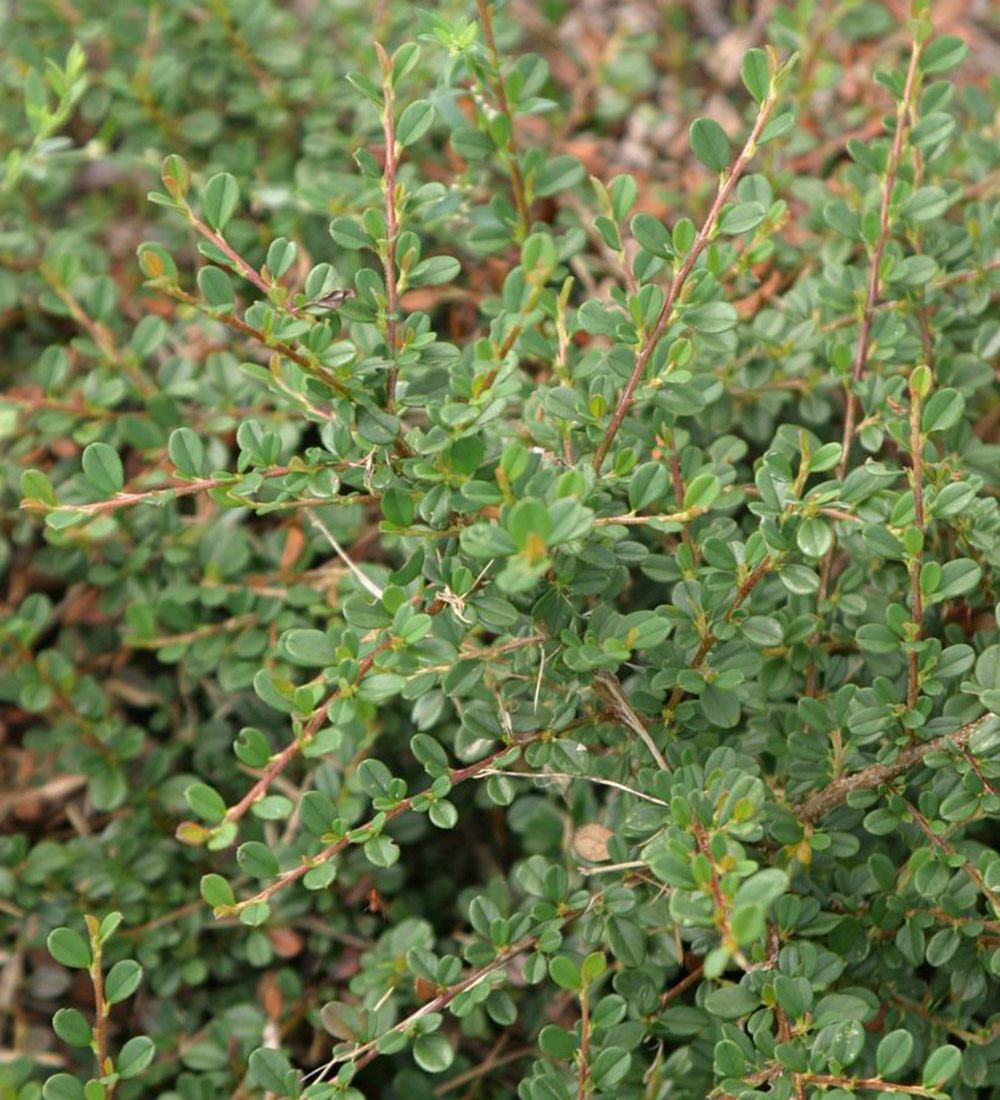
Name: Cotoneaster dammeri ‘Streibs Findling’
Zones: 5–8
Size: 1 foot tall and 6 feet wide
Conditions: Full sun to partial shade; well-drained soil
Native range: Central and southern China
‘Streibs Findling’ bearberry cotoneaster is a tiny, densely branched evergreen that is perfect for erosion control in a sloped rock garden. Layers of small, glossy, blue-green leaves create a flowing ground cover that inhibits the growth of weeds. Branches are adorned with abundant star-shaped white flowers in spring and bright red berries in fall. The habit is very low and nicely spreading, with individual plants reaching up to 6 feet in width. Adaptable to either full sun or partial shade, ‘Streibs Findling’ is somewhat deer resistant and definitely worth a try.
‘Nikko’ slender deutzia smothers itself in summer blossoms
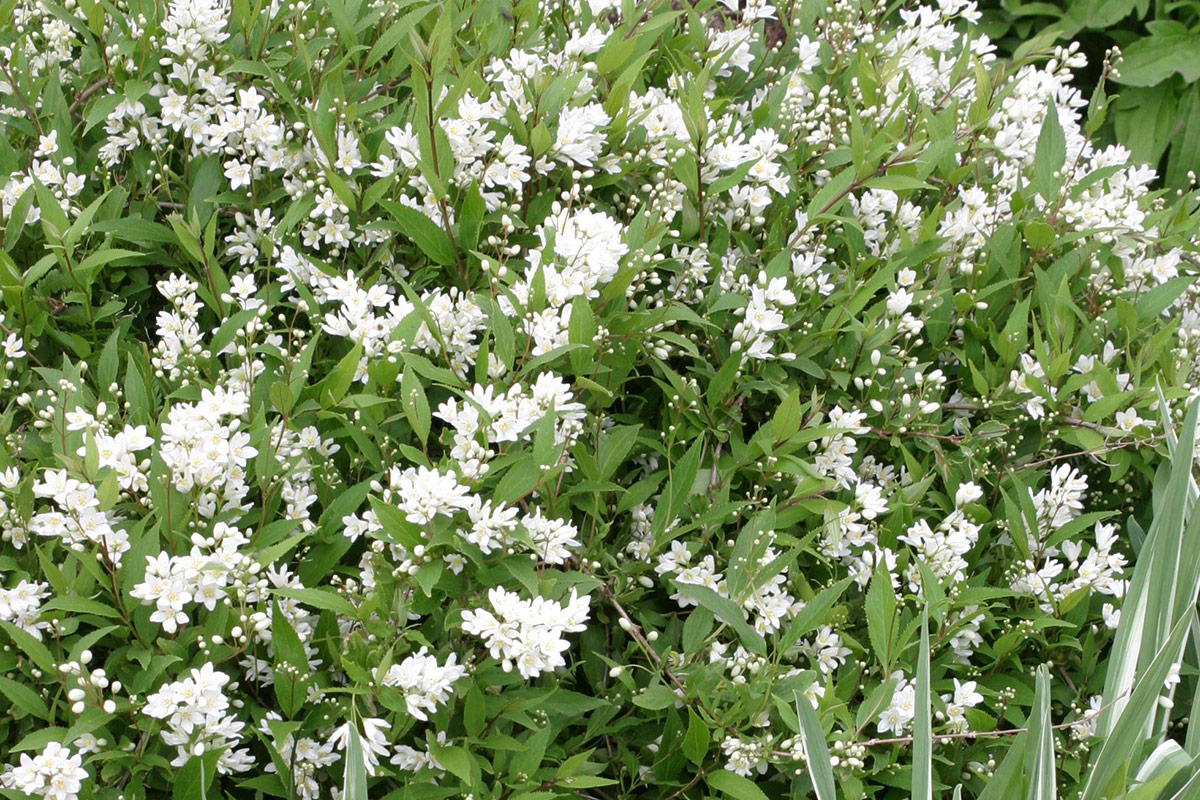
Name: Deutzia gracilis ‘Nikko’
Zones: 5–8
Size: 1 to 2 feet tall and 2 to 5 feet wide
Conditions: Full sun to partial shade; average to moderately moist, well-drained soil
Native range: Japan
‘Nikko’ slender deutzia is a slow-growing, broadly mounded shrub with an abundance of elegant, clear white flowers in early summer. This plant is ideal for siting next to a rock or low wall to soften and settle it. We also like growing it under paper birch trees (Betula papyrifera and cvs., Zones 2–7); in summer the crisp blooms heighten the effect of the trees’ white bark, and in fall ‘Nikko’ has deep purple foliage that contrasts nicely with the birches’ golden leaves.
Southern bush honeysuckle has strong roots that will hold an embankment in place
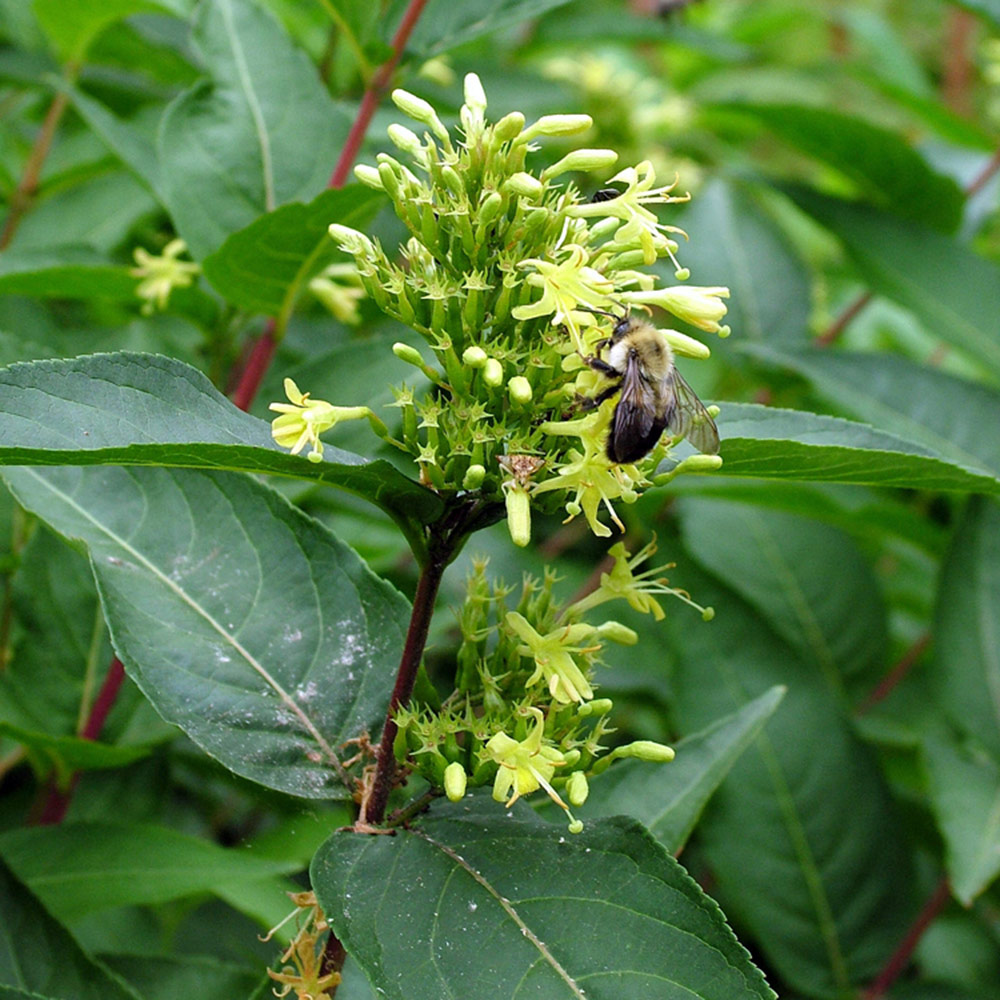
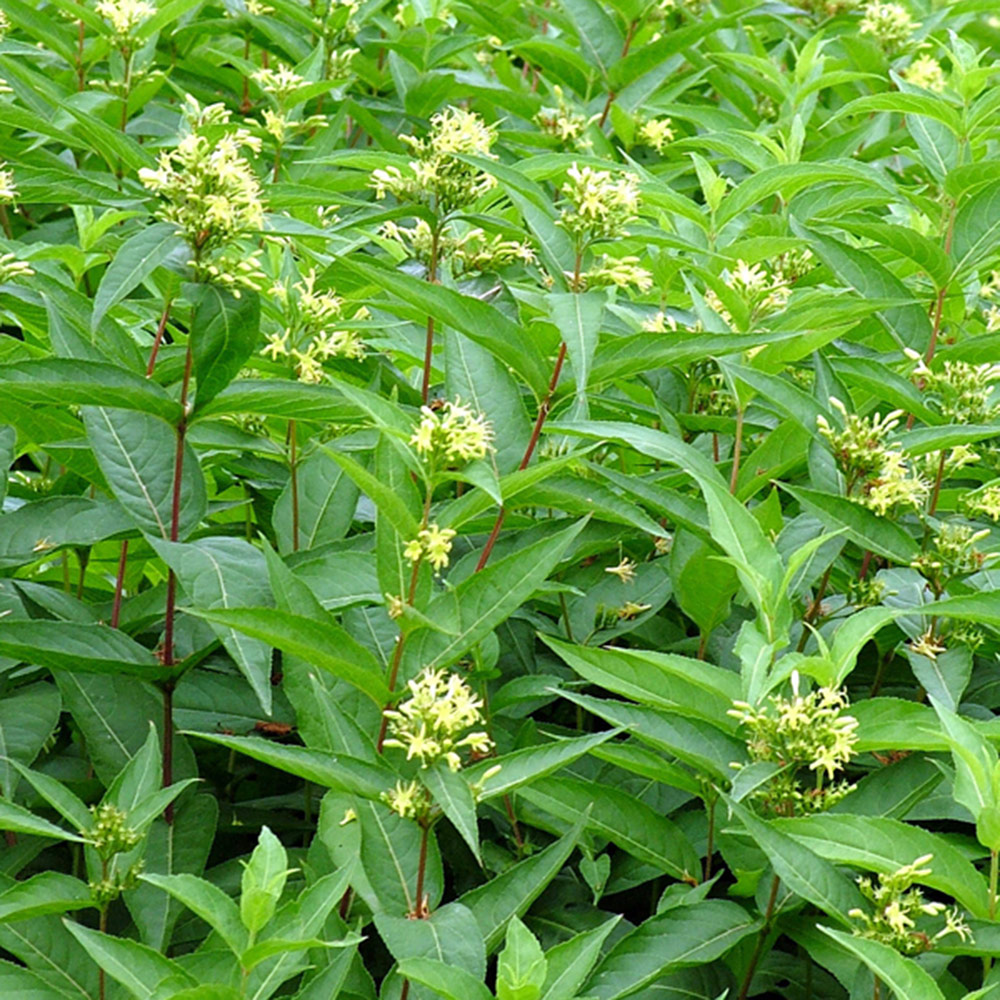
Name: Diervilla sessilifolia
Zones: 5–8
Size: 3 to 6 feet tall and wide
Conditions: Full sun to partial shade; average to dry, well-drained soil
Native range: Southeastern United States
Southern bush honeysuckle, which is native to the southern Appalachian Mountains, is another excellent shrub for stabilizing slopes. Although it spreads by underground rhizomes, it is not unruly or intrusive. This adaptable shrub sports fragrant, trumpet-shaped summer flowers that attract hummingbirds, butterflies, and bees over a long period from June to August. The only maintenance it needs is a little general shaping and a light cutback of old stems after it finishes flowering.
‘Daub’s Frosted’ juniper has new growth that glows
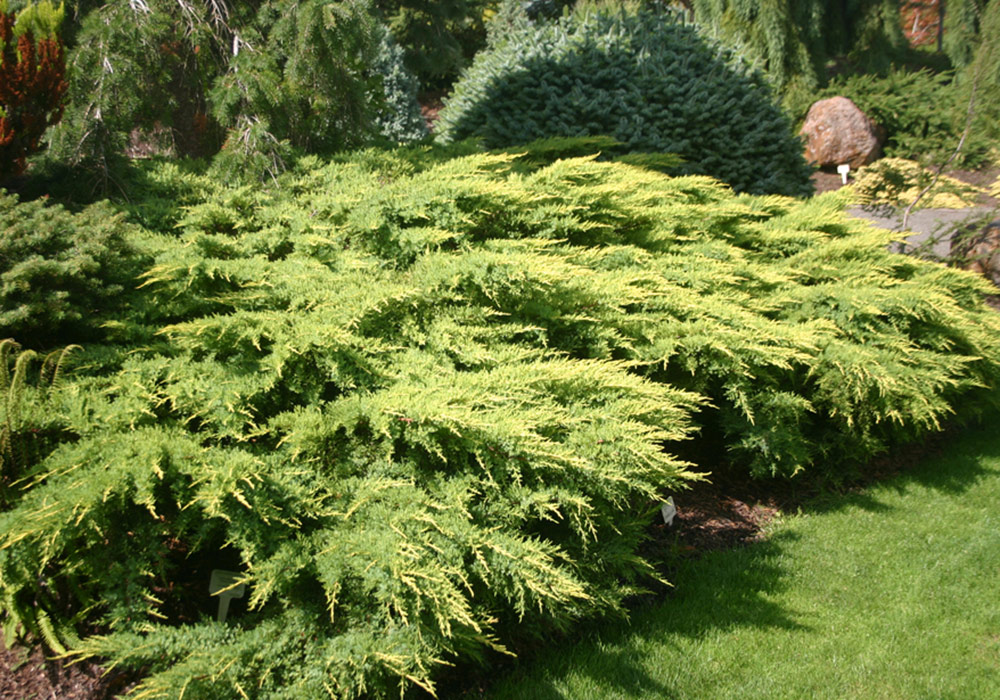
Name: Juniperus × pfitzeriana ‘Daub’s Frosted’
Zones: 4–9
Size: 1 to 2 feet tall and 3 to 6 feet wide
Conditions: Full sun; well-drained soil
Native range: Hybrid
‘Daub’s Frosted’ juniper is a great evergreen with blue-green needles that are frosted with pale-gold new growth at the branch tips. Some sources say it only grows 2 feet tall and 5 feet wide, but we have a beauty on our hillside that has grown well beyond those dimensions. Photos of this plant do not do it justice; it is truly best appreciated in person. Its arching branches grow in layers, with each one a bit longer than the one above, giving it an exceptionally graceful appearance descending down a slope. Our specimen looks great every month of the year, and the deer have not touched it.
Trees Create Vertical Accents and Serve Up Seasonal Color
Heritage® river birch is stunning in every season

Name: Betula nigra ‘Cully’
Zones: 4–9
Size: 40 to 70 feet tall and 40 to 60 feet wide
Conditions: Full sun to partial shade; average to wet soil
Native range: Eastern North America
Heritage® river birch is a fast-growing cultivar of a beloved native species with good disease and pest resistance. The exfoliating bark adds year-round interest, especially in winter. Although river birch is often found along stream banks and flood plains in the wild, we have successfully grown several specimens on high, dry, sunny hillsides. It actually prefers lean soil; if the soil is too rich, the wood becomes weak over time. The glossy leaves flutter beautifully in the wind, and the tree has a soft gentleness that could enhance almost any design.
‘Taylor’ eastern red cedar has a narrow, vertical form
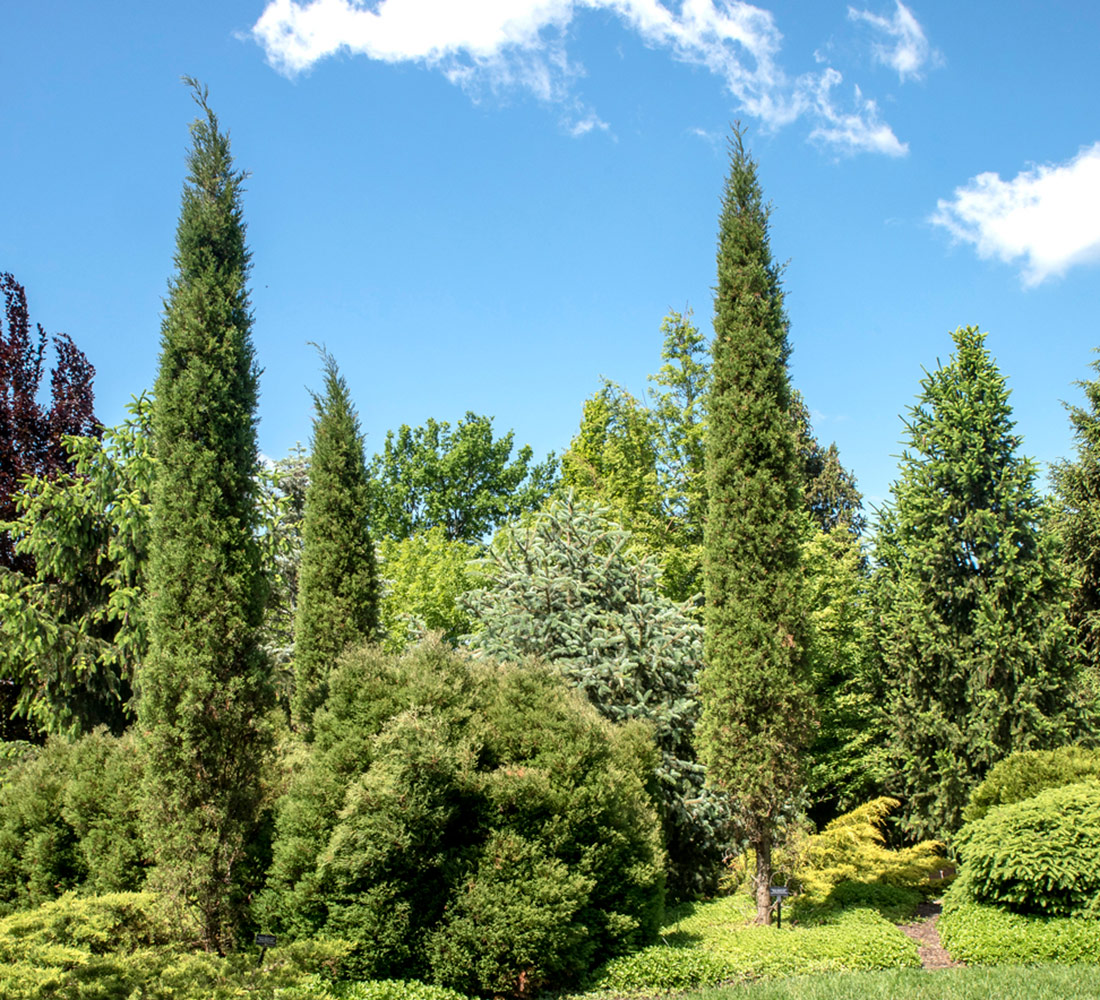
Name: Juniperus virginiana ‘Taylor’
Zones: 4–9
Size: 15 to 20 feet tall and 3 to 4 feet wide
Conditions: Full sun; average to moist, well-drained soil
Native range: Eastern North America
‘Taylor’ eastern red cedar has a narrow, columnar habit that is quite useful for creating a strong vertical accent on a hill. If you like the appearance of Italian cypress (Cupressus sempervirens, Zones 7–10), this is a cold-hardy alternative that could be used to achieve a similar effect in a sunny spot with good air circulation. The silvery blue–green foliage is evergreen, providing good year-round garden structure, and is also very deer resistant.
‘Pendula Rosea’ weeping cherry adds movement to a hillside design
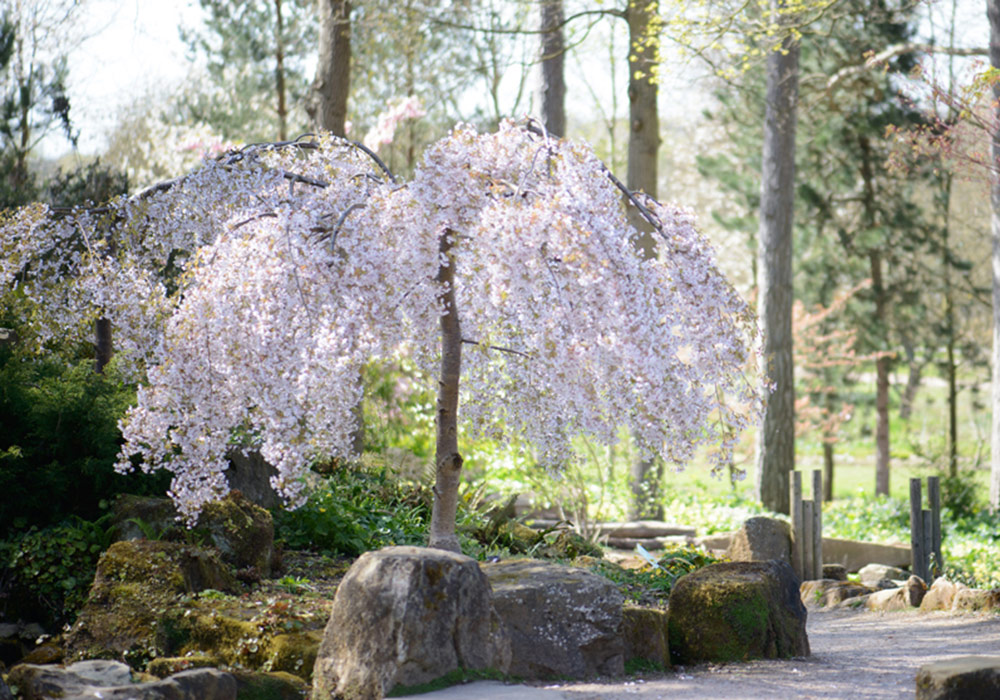
Name: Prunus pendula ‘Pendula Rosea’
Zones: 5–8
Size: 15 to 25 feet tall and wide
Conditions: Full sun to partial shade; moist, fertile, well-drained soil
Native range: Japan
‘Pendula Rosea’ weeping cherry is a splendid cultivar with classic, single pink flowers that are a welcome sight in spring. It is frequently top-grafted onto hardy rootstock that provides the height needed for this tree to properly display its weeping habit. The branches trail over each other in stacked layers that gracefully descend one upon the other, creating a sloped appearance. Be sure to watch for graft reversions, and promptly prune out any nonweeping suckers that emerge. For a gardener who is creatively inclined, a sloping site can be full of potential. Choose your plants with care, and you can create a hillside combination that lifts your spirits each time you see it.
Use Plant Architecture to Make a Slope More Interesting
Hillside plantings should be easy to maintain, but they don’t need to be monotonous. Here are a few tips for enhancing the effect of a sloping site.
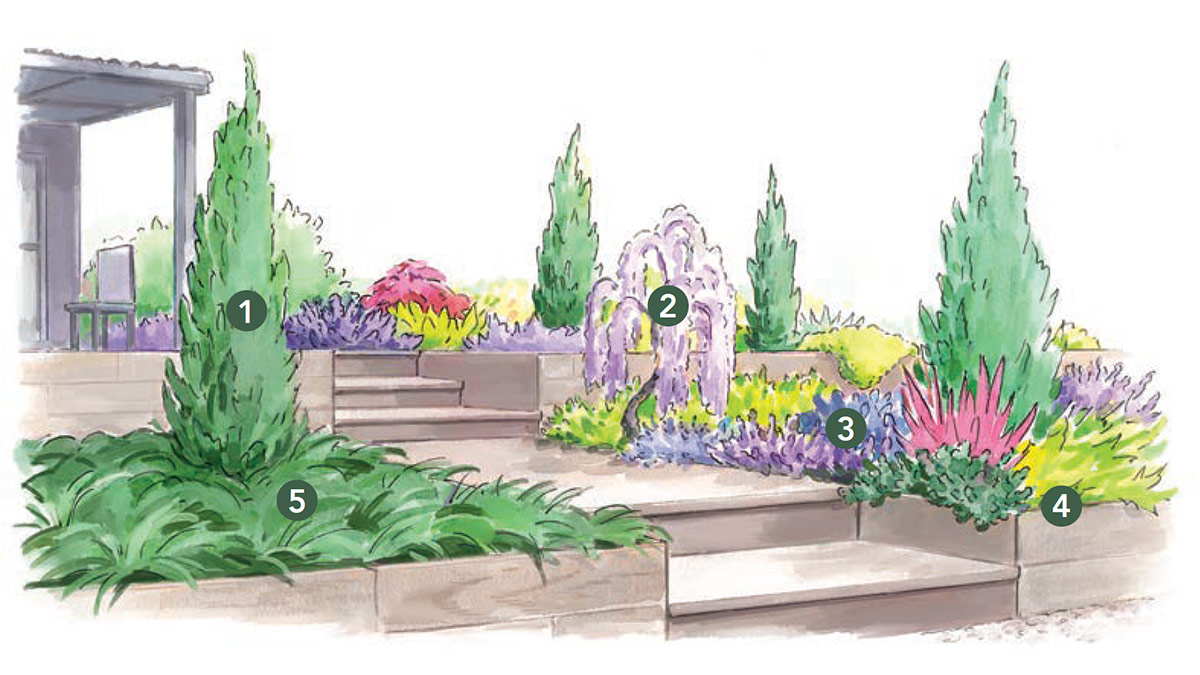
1. Vertical trees and shrubs create engaging visual dynamics
For focal points that draw attention and create movement on a steep grade, fastigiate plants will not disappoint.
2. Use weeping trees for a cascading effect
Trailing branches that gently draw the eye downward combined with the verticality of a slope create a lively visual tension.
3. Create tapestries of texture and color
Combine low-growing shrubs and perennials that love the good drainage a slope provides. Heaths (Erica spp. and cvs., Zones 5–8) and heathers (Calluna vulgaris and cvs., Zones 5–8) thrive in these conditions.
4. Consider terracing
If you need to access the slope, a series of terraces with steps in between can make a hill feel less high. With each terrace comes another opportunity for garden beds that are relatively flat. Retaining walls help with erosion and make the slope even more accessible.
5. For a refined look, try planting in drifts
An uninterrupted swathe of no-mow grass, low-growing shrubs, or any other minimalistic ground cover will help the slope blend in quietly.
Catharine Cooke and Ian Gribble are the principal designers and owners of Spring Lake Garden Design in Sherman, Connecticut.
Sources
The following mail-order sellers offer many of the plants featured here:
- American Meadows, Shelburne, VT; 802-227-7200, americanmeadows.com
- Bluestone Perennials, Madison, OH; 800-852-5243, bluestoneperennials.com
- Dancing Oaks Nursery, Monmouth, OR; 503-838-6058, dancingoaks.com
- Forestfarm, Williams, OR; 541-846-7269, forestfarm.com
- Midwest Groundcovers, St. Charles, IL; 847-742-1790, midwestgroundcovers.com


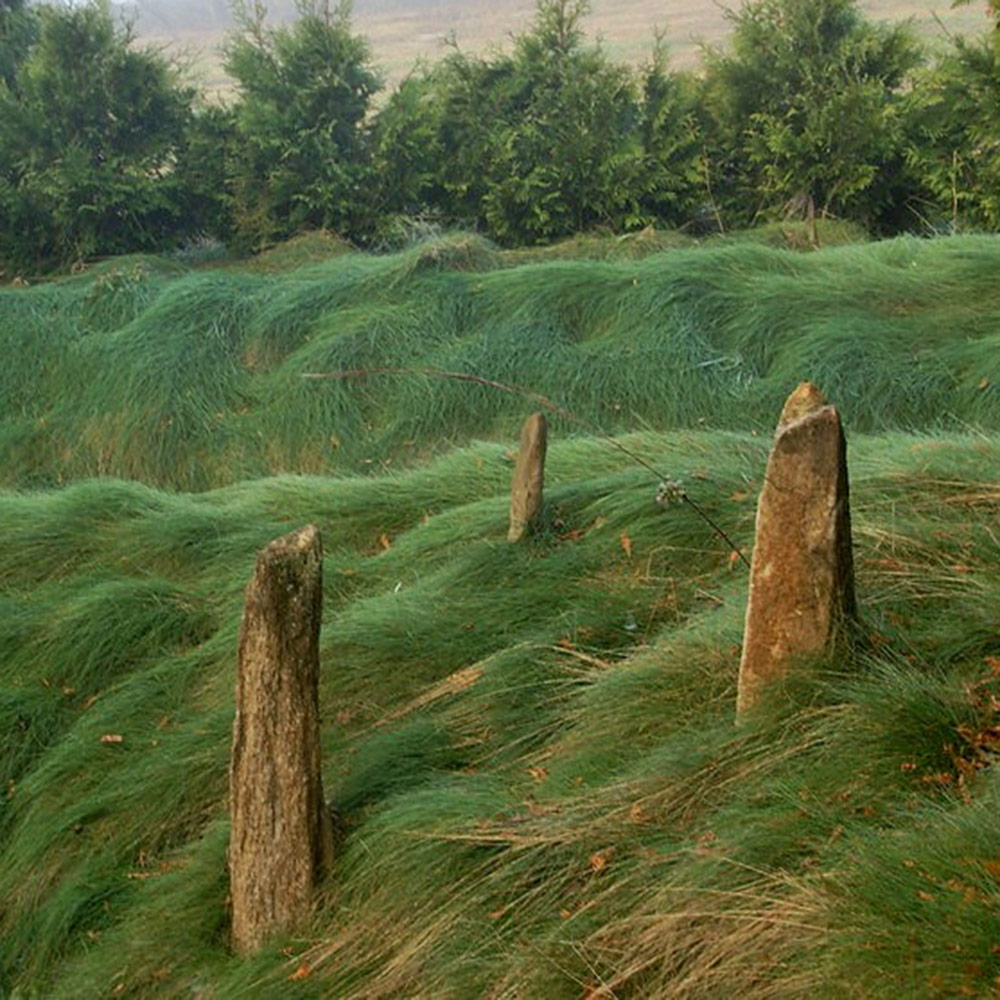



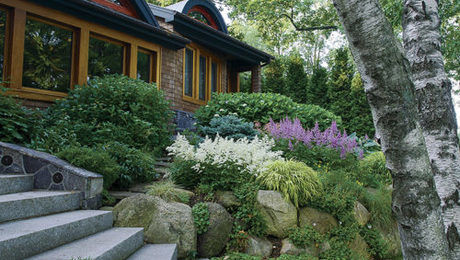












Comments
Log in or create an account to post a comment.
Sign up Log in